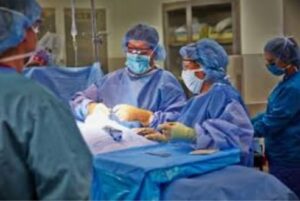 Some women may have an operation called pelvic exenteration for cervical cancer that has come back within the pelvis. There are three types of pelvic exoneration:
Some women may have an operation called pelvic exenteration for cervical cancer that has come back within the pelvis. There are three types of pelvic exoneration:
- anterior (front) exenteration
- posterior (back) exenteration
- total exenteration
Anterior (front) exenteration
With this operation, your surgeon removes the:
- cervix, womb, ovaries and all or part of the vagina
- lymph nodes
- bladder
After this operation you have an opening on the surface of your tummy (abdomen), called a stoma or urostomy. Your urine flows down the tubes from your kidneys (the ureters) and out of the stoma into a bag.
You might have a continent urinary diversion. This means you have a small pouch made from part of your bowel. This stores your urine inside your abdomen. You still have a stoma but urine doesn’t leak out of it. There is a natural valve inside the part of the bowel used for the operation that keeps the stoma closed. To drain off the urine, you put a thin tube (catheter) into the stoma several times a day.
Posterior (back) exenteration
In this operation your surgeon removes the:
- cervix, womb, ovaries and all or part of the vagina
- lymph nodes
- back passage (rectum) and part of the large bowel (colon)
After this operation you have an opening on the surface of your abdomen called a stoma or colostomy. You wear a bag over the stoma to collect your feces.
Total exenteration
In this operation your surgeon removes the:
- cervix, womb, ovaries and all or part of the vagina
- lymph nodes
- lower bowel and rectum
- bladder
After this operation you have both a colostomy and a urostomy. You will need to have a bag to collect your feces and a bag to collect your urine. In some hospitals, you may have one opening for both feces and urine.
Vaginal reconstruction
If your doctor needs to remove all of your vagina they might be able to make a new one from skin and tissue from other parts of your body. Your doctor will talk to you about this before the operation so you know what to expect.




